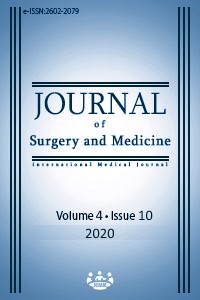Airway management of a huge thyroid mass: A case report
Keywords:
Difficult airway, Fiberoptic, Huge goiter, EntubationAbstract
In large thyroidal masses with excessive tracheal shift, the laryngeal opening is usually in the normal position and intubation may not be difficult. However, in some cases, such as retrosternal big thyroid glands, airway management can get challenging. Failure to successfully manage difficult airways is responsible for 30% of deaths attributed to anesthesia, with approximately 600 deaths annually. Successful awake intubation can be performed in 88-100% by considering the appropriate position and experience of anesthesiologist with a fiberoptic bronchoscope. However, the path to be followed should be determined according to each patient.
Downloads
References
Bajwa SJS, Sehgal V. Anesthesia and thyroid surgery: The never ending challenges. Indian J Endocr Metab. 2013;17:228-34.
Shaha AR. Difficult airway and intubation in thyroid surgery. Ann Otol Rhinol Laryngol. 2015;124(4):334-5. doi: 10.1177/0003489414553654.
Amathieu R, Combes X, Abdi W, Housseini LE, Rezzouq A, Dinca A, et al. An algorithm for difficult airway management, modified for modern optical devices (Airtraq Laryngoscope; LMA CTrachTM) a 2-year prospective validation in patients for elective abdominal, gynecologic, and thyroid surgery. Anesthesiology. 2011;114:25-33.
Wakeling HG, Ody A, Ball A. Large goitre causing difficult intubation and failure to intubate using the intubating laryngeal mask airway: lessons for next time. Br J Anesth. 1998;81:979–81.
Tutuncu AC, Erbabacan E, Teksoz S, Ekici B, Koksal G, Altintas F, et al. The Assessment of Risk Factors for Difficult Intubation in Thyroid Patients. World J Surg. 2018;42(6):1748-53. doi: 10.1007/s00268-017-4391-y.
Orozco-Diaz E, Alvarez-Rios JJ, Arceo-Diaz JL, Ornelas-Aguirre JM. Predictive factors of difficult airway with known assessment scales. Cir Cir. 2010;78(5):393-9.
Gómez-Ríos MA. Can fiberoptic bronchoscopy be replaced by video laryngoscopy in the management of difficult airway? Rev Esp Anestesiol Reanim. 2016;63:189-91.
Gómez -Ríos MA, Gaitini L, Matter I, Somri M. Guidelines and algorithms for managing the difficult airway. Rev Esp Anestesiol Reanim. 2018;65(1):41-8. doi: 10.1016/j.redar.2017.07.009.
Voyagis GS, Kyriakis KP. The effect of goiter on endotracheal intubation. Anesth Analg. 1997;84:611-2.
Adnet F, Barron SW, Racine SX, Clemessy JL, Fournier JL, Plaisance P, et al. The intubation difficulty scale (IDS): proposal and evaluation of a new score characterizing the complexity of endotracheal intubation. Anesthesiology. 1997;87:1290-7.
Paix AD, Williamson JA, Runciman WB. Crisis management during anaesthesia: difficult intubation. Qual Saf Health Care. 2005;14:e5.
Nimmagadda U, Salem MR, Crystal GJ. Preoxygenation: physiologic basis. Benefits, and potential risks. Anesth Analg. 2017;124:507-17.
Reasoner DK, Warner DS, Todd MM, Hunt SW, Kirchner J. Acomparison of anesthetic techniques for awake intubation in neurosurgical patients. J Neurosurg Anesthesiol. 1995;7:94-9.
Zaouter C, Calderon J, Hemmerling TM. Videolaryngoscopy as a new standard of care. Br J Anaesth. 2015;114:181-3.
Popat M, Mitchell V, Dravid R, Patel A, Swampillai C, Higgs A. Difficult Airway Society guidelines for the management of tracheal extubation. Anaesthesia. 2012;67:318-40.
Downloads
- 854 874
Published
Issue
Section
How to Cite
License
Copyright (c) 2020 Ahmet Gültekin, İlker Yıldırım, Ayhan Sahin, Cavidan Arar
This work is licensed under a Creative Commons Attribution-NonCommercial-NoDerivatives 4.0 International License.
















